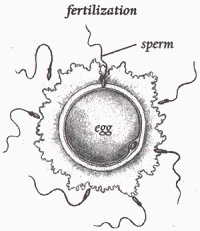
|

The human egg is huge - 250 times bigger than a normal red blood cell, and it weighs 100-fold more.
Its nucleus, reminiscent of the great swirling spot of Jupiter, dominates the inner reaches of its
cytoplasm1. Those sperm that reach the egg's outer surface look like explorers on a vast, curving
landscape. (The sheer number of male gametes2 make up for their small size. On average, over 100 million
sperm attempt to reach the egg.) Once fertilized, the egg becomes the ancestor of all cells, including
stem cells. Within it lays a nascent3 power that science has only begun to understand.
Fertilization occurs when one sperm penetrates the egg's outer membrane, as illustrated in the figure
to the right.
The chromosomes from each parent merge in one nucleus, and development begins. Little is
known about the delicate process of early human development - much has to be inferred from studies of
other animals. But animal research shows that both the male and female genomes are required to start
the process. After fertilization is finished, the egg is called a zygote (from the Greek zygous,
meaning yoked4). At this stage the zygote - the earliest form of the embryo - is just a single cell,
capable of becoming a complete organism. Survival isn't a sure bet - nearly half the zygotes die at
this stage. But if it thrives, it will embark on a remarkable journey. It will become trillions of cells;
its infinitesimal mass will grow to well over a hundred pounds, and its individual character will change
into dozens of complex organs, such as the liver, the heart, and the brain.
|
 |
About one day after fertilization, the formation of the embryo begins. The zygote begins a series of
mitotic5 divisions, collectively called cleavage6, that result in
smaller and smaller cells. Imagine dividing a perfectly plastic soap bubble (one that won't pop when
you cut it) with a knife. Where there was one bubble, now there are
two smaller bubbles. Cut it again, and four bubbles appear. In the zygote, a similar process repeats
for several more cycles, resulting in eight cells, sixteen cells,
thirty-two cells, and so on, surrounded by a transparent membrane. Just like our soap bubble, the
total volume changes very little as the zygote divides. The progression
of drawings on the right
shows that each new cell is smaller than the one that preceded it. The interior
becomes quite crowded with densely packed cells.
At three days the embryo resembles a mulberry, hence its Latin name, the morula. On the fourth day,
fluid passing into the morula forms a cavity7. The cells
rearrange somewhat into two regions, an outer layer called the trophoblast (from the Greek trophe,
or nutrition) and a few dozen internal cells, called the inner cell
mass or ICM, the source of embryonic stem cells. At this stage, between four and six days old, the
developing embryo is called a blastocyst. Embryonic stem cells is a term used for laboratory cultures
of cells made from the ICM of blastocysts. The genes involved in development have begun an important
initial task: instructing the cells of the trophoblast to change into the placental8 and amniotic
tissue that will eventually support the embryo. These genes also send cues to the ICM that eventually
cause it to develop into the embryo proper.
The term embryo is easily misunderstood when taken out of the context of early development. The zygote,
the morula, and the blastocyst are the earliest kinds of embryos, and there are nineteen other recognized
stages before fetal development begins. Embryologists also call the blastocyst the early or
pre-implantation embryo because it has not yet attached to the uterus. The four-day-old embryo - the
blastocyst - is a corpuscle10 about 0.1 millimeter across, smaller than the period at the end of this
sentence.
645 words
|
 |
Source: Stem Cell Now by Ch. Th. Scott, A Plume Book, USA, 2006, pp. 25-27
Annotations:
1. cytoplasm - jelly-like insides of the cell bound by the plasma membrane
2. gametes - mature egg (oocyte) or sperm (spermatocyte); cells that carry genes to the next generation
3. nascent - im Entstehen begriffen, aufkeimend
4. yoked - gepaart
5. mitotic: from mitosis = central featture of cell division that includes duplication of identical
copies of chromosomes
6. cleavage - Zellteilung
7. cavity - Hohlraum
8. placental - from: placents = spongy tissue in the uterus from which the embryo gets nourishment
an oxygen
9. amniotic fluid - Fruchtwasser
10. corpuscle - Korpuskel, Teilchen
Assignments:
1. Under what circumstances does fertilization occur?
2. When does human development begin in an egg?
3. What is characteristic of a zygote and what happens in it after fertilization?
4. Where do embryonic stem cells originate from?
5. What is the main task of genes in a fertilized egg after its 6th day of existence?
6. How many developmental stages are there before fetal development begins? Name the first three.
7. When do we talk of a real human embryo?
|


